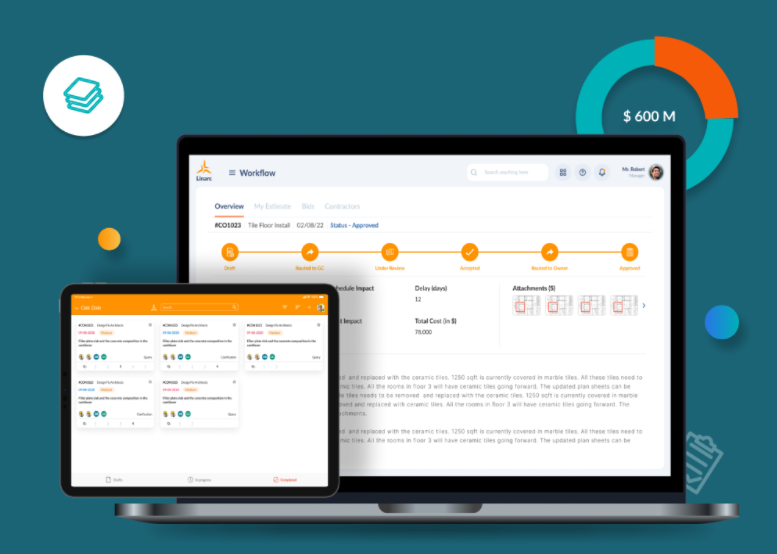Automating Construction Submittal Workflows To Save Money

Construction Submittal Workflows can be automated with custom construction project management software like Linarc.
Submittals are one of the staples of the construction industry. When contractors are about to begin a section of work, they submit the resources they plan on using to the architects and project planners for their verification and approval. These can entail material samples, product data, shop drawings, equipment types, and any other project specific details related to their work.
This process ensures that the contractors are working with owner approved materials prior to any of the work being completed. For example, if a type of paving stone, paneling, or any other construction material, is not up to the designers’ standards, they can address the issue before its ordered in bulk and installed into the project.
Like many processes, the submittal process can be redundant, time consuming, and requires a large degree of project management and administrative overview to carry out. First, the list of items that need to be submitted needs to be built. From there, each item needs to be collected, packaged and sent to the owners for their review. This entails keeping a record of exactly what was submitted, when, and including a variety of details such as requested approval date and who the submittal is being sent to.
Once the submittal is ready it needs to be handed off to the appropriate party, and then followed up on to get a quick reply. Project managers and administrators will need to follow up on them to get the architect’s attention to review submittals in a timely manner. Submittals are intended to be a stop-gap to prevent the construction project from steering off-course and using the wrong resources. But sometimes, they can be a delay mechanism that keeps the project from completing on time.
Some contractors may not be as organized and may take longer to process their submittals. Or maybe they’re just busy out on site and are overburdened with day-to-day tasks. Sometimes their vendors may be slow in getting them the product or information they need. Or the architects may take a bit longer to review them. To be sure, an architect’s “stamp” doesn’t come lightly, and they intend to give a full and proper review of the submittals that arrive at their office. Weekends, holidays, and the distraction of all their other responsibilities, can cause longer turnaround times.
Project managers are well aware of this and are usually good at prompting contractors to complete their submittals, and getting architects to review them. This, of course, takes a lot of time for the project managers to ensure the submittals are moving along so they won’t delay the project. While project managers are following up with a myriad of submittals, the rest of the project managerial duties may get backlogged.

Automating The Construction Workflow Submittal Process
Construction Project Management software like Linarc, solves this problem. It automates the submittal process from start to finish. Rather than rely on a manual process managed by project coordinators, we manage the process for you. Here’s how we streamline construction submittal approvals.
The core of Linarc is the Project Master Schedule. The schedule holds not only all the tasks, but all the equipment, materials, personnel, and resources needed to complete the task. So the first step is part of our regular onboarding – add your project to the project schedule. Once all the details are in our system, we can guide the submittal process for you. This includes following the Work Breakdown Structure and using industry standard task codes for each task. Start and ends dates are included so we can project when certain actions need to take place, including the submittal process.
In order to manage your submittal process, we have a tool to design each checkpoint along the way. This will vary from company to company, but typically starts with contractors, and ends with architects or owners. Each person that needs to review the submittals will be added to a submittal communications sequence. The required steps for that person are outlined so everything’s clearly planned out in advance. Some steps may be informational so everyone knows what’s going on, some steps may require them to apply their review, oversight, and commentary to proceed to the next step.
For example, contractors will need to prepare the submittal and fill out some details about it. For example, they’ll prepare the technical specs of an aggregate along with a sample. They’ll then enter into Linarc to begin the submittal process. This way we can keep a clear record and submittal log for you, and simultaneously expeditiously launch the review process. Next, project managers may be notified so they know things are moving forward. Then architects will be notified to review the submittal and to review it promptly. They’ll receive reminders so it stays front of mind until completed. Once reviewed, all will be notified of the results. Depending on their response, either a new item will need to be found as a replacement, or the original will be accepted for use in the project.
Beyond automating submittals for one project, Linarc makes it easy to reuse the same submittal automations across all projects. That way once you get everything set up and ready to go, and once you get the entire team accustomed to the automated submittal process with Linarc, you can roll it out to all your projects.
By letting Linarc automate your submittal process we ensure it gets done faster, more accurately, and more efficiently. Each person in the submittal chain is able to take the handoff, complete their part, and keep the process moving. The paperwork and paper trail is clear and readily accessible for reviews and inspections.
Moreover, Linarc’s reporting system makes it clear where each submittal is at each stage of the process. With a few clicks project overseers can see exactly where their attention is needed, and, as may be the case from time to time, conduct some good ole fashioned project management work. E.g., get on the phone, and get people to focus on keeping the process moving. Linarc makes that the exception, and not the way project managers end up spending much of their time.




